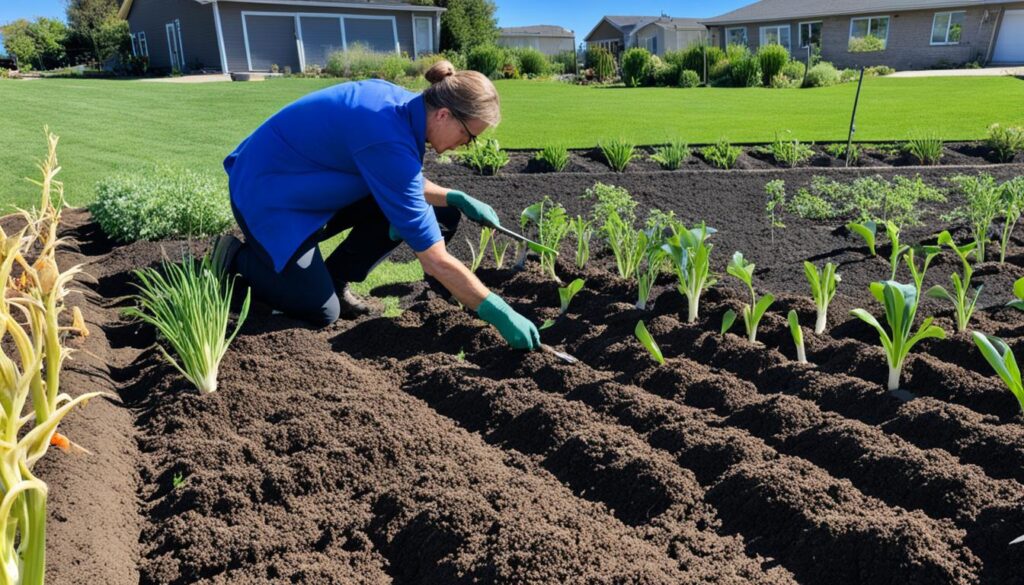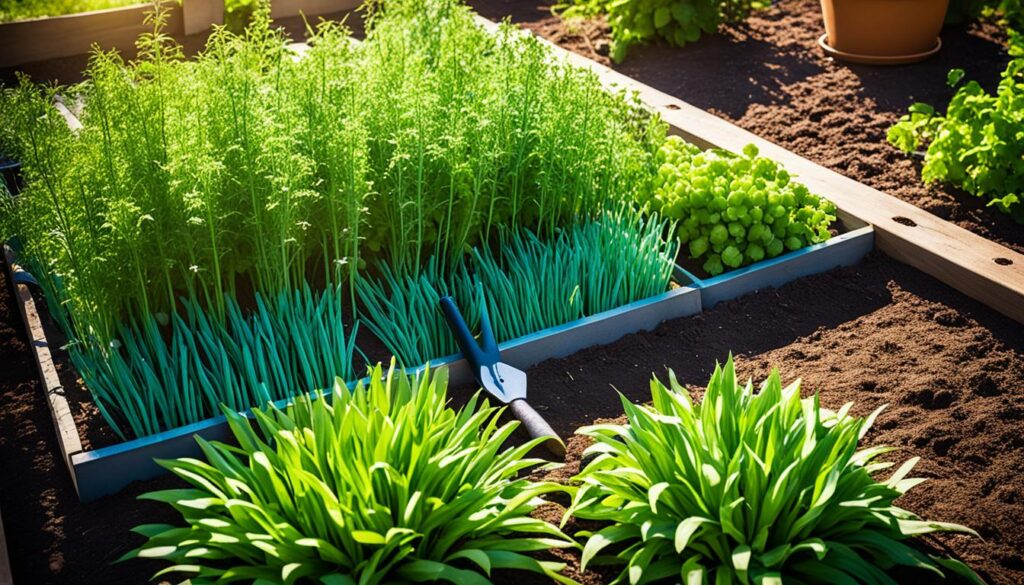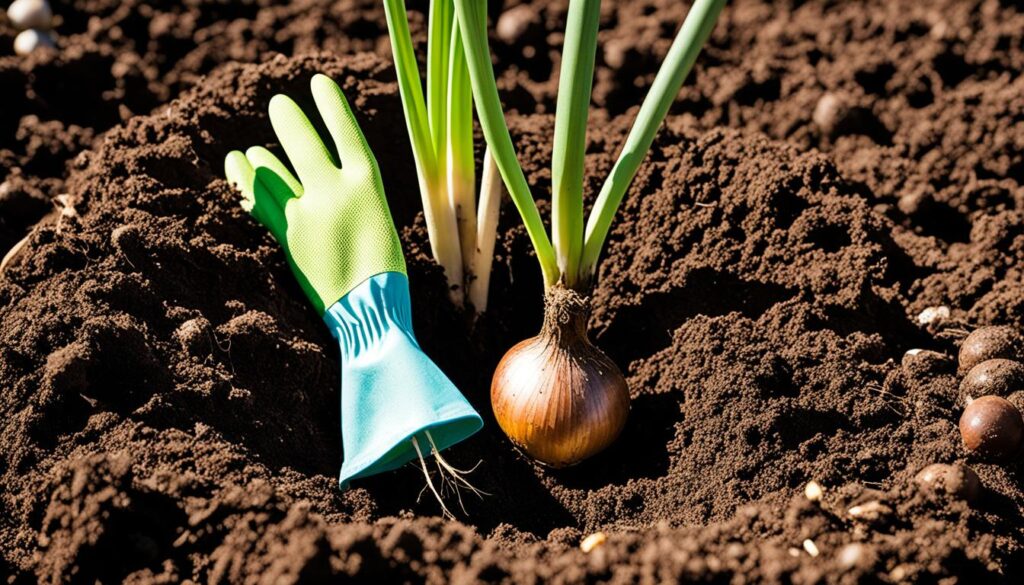Planting onions is easy and fun. They are hardy and give a tasty crop. You just need to know when to plant and how to choose the seeds or sets. Also, preparing the soil right is key to growing big, tasty onion bulbs in a few months.
For growing onions, you can start from seed or use onion sets. There’s no right or wrong way. Seeds need more time but are cheaper. Many like sets for being easy to use and for results soon. Sets are small onions started for you that go right into the garden in the spring.
With a few growing tips, growing onions is very rewarding. This complete guide helps at every step for good harvests. So, let’s learn the best way to grow these tasty vegetables in your garden!
Key Takeaways
- Onions are easy to grow and yield a delicious, versatile crop
- You can start onions from seed or plant onion sets
- Growing from seed takes more time but is less expensive
- Onion sets are convenient and produce quick results
- Proper soil preparation is key to growing healthy onions
Choosing the Right Onion Variety
Choosing the right onion type is key for a good crop. There are long-day, short-day, and day-neutral onions. Knowing what’s best for your area will help you grow tasty onions.

Long-Day Onions
Long-day onions are great for places with long summers, like the north. They need lots of sunlight, about 14 to 16 hours a day, to grow bulbs. Some top long-day picks are:
- Yellow Sweet Spanish
- First Edition
- Red Wethersfield
- Aisa Craig
- Walla Walla
- Buffalo
- Norstar
- Copra
- Southport Red Globe
- Sweet Sandwich
- Yellow Globe
- Red Florence
Short-Day Onions
Short-day onions do best where summers are shorter, like in the south. They only need 10 to 12 hours of sunlight. Some favorites are:
- Stuttgarter
- White Bermuda
- Red Burgundy
- Crystal Wax White Bermuda
- Hybrid Yellow Granex
- Southern Belle
- Texas 1015-Y Supersweet
Day-Neutral or Intermediate Onions
Day-neutral onions fit almost anywhere because they grow well with different daylight. These onions need 12 to 14 hours of sunlight. Some good ones are:
- Candy
- Red Stockton
- Super Star
| Onion Type | Daylight Hours Required | Suitable Growing Regions |
|---|---|---|
| Long-Day | 14-16 hours | Northern regions |
| Short-Day | 10-12 hours | Southern regions |
| Day-Neutral/Intermediate | 12-14 hours | Most regions |
Decide whether to grow from seeds or sets by thinking about your skill and time. Growing from seeds needs more work but gives more choices. Sets are simple to plant and grow, which many people like.
Preparing the Soil for Planting
Getting the soil ready before planting onions is very important for a good harvest. Growing big, healthy onions needs soil that’s loose and drains well. It should also be full of organic matter. Spending time to prepare the soil will help you grow lots of tasty onions.
Soil Requirements
Onions like full sun and need fertile soil. It should be improved with lots of compost or aged manure. A good pH level for them is between 6.0 and 6.8.
If your soil is too heavy or too sandy, you can fix it by adding organic matter. This will make the soil better for holding nutrients. Onions need soil without rocks, debris, or compaction. This helps their bulbs grow properly.

Improving Soil Quality
To make a great place for onions to grow, do these steps to your soil:
- Choose a sunny spot in your garden that gets 6 hours of sunlight every day.
- In fall or early spring, add lots of compost or aged manure. Mix it in 8-12 inches deep. This step makes the soil richer and helps with drainage.
- Use a garden fork to loosen up compacted soil and remove clumps. Onions need soft soil to grow big.
- Level the soil with a rake, and take out any rocks or debris. This helps onions to grow without problems.
- You can cover the soil with cardboard or a silage tarp. This keeps weeds away and helps the soil. The cardboard will break down and add to the soil’s health.
- Before you plant, spread 1-3 inches of finished compost on top. This gives your onions lots of nutrients as they grow.
Properly preparing your soil means you’ll get a big crop of tasty onions. Good soil is the key to growing healthy plants. They will give you a great harvest all season long.
How to Plant Onion
Planting onions is easy. You can start from sets or seeds. Both ways give you lots of tasty onions. I’ll show you how to plant and care for them for the best results.
Planting Onion Sets
Many gardeners like using onion sets. They are easy to plant and grow quickly. Push each set into the soil, but keep the bulb part covered. The pointy end should be sticking out. Plant them 4 to 5 inches apart. Onions planted this way are ready in 3 to 4 months. When the green tops start to turn yellow, it’s time to harvest.

Planting Onion Seeds
In cold areas (Zone 5 and lower), grow onions from seed. Soil should be at least 50°F for seeds to sprout. Start seeds indoors 6 weeks before it’s warm enough outside. Then move them to the garden. Plant them 4 to 5 inches apart in rows spaced 12 to 18 inches apart.
Spacing and Depth
Good spacing and depth are key for healthy onions. Bury onion sets 2 to 6 inches apart, just pressing them in 1 to 2 inches deep. For green onions, you can plant closer at 2 inches apart. For seeds, plant 4 to 5 inches apart. Always plant with the pointy end up. Don’t bury them more than 2 inches deep.
| Planting Method | Spacing | Depth |
|---|---|---|
| Onion Sets | 4-5 inches apart | 1-2 inches deep |
| Onion Seeds (Transplants) | 4-5 inches apart (rows 12-18 inches apart) | 1-2 inches deep |
Follow these steps for a great onion harvest. With care, you will have plenty of tasty onions for your meals.
Caring for Your Onion Plants
To get a lot of onions, you must take good care of your plants all year. They need water, food, and to be kept safe from bugs and weeds. Do this, and you will have big, healthy onions to keep for a long time.

Watering
Onions like a lot of water, but not too often if you use mulch. They need about 1 inch of water every week, even if it rains. Change how much you water based on the weather and how your garden is doing.
Fertilizing
Giving onions food is very important for them to grow big and healthy. When you plant them, put in some food that has a lot of nitrogen. Some gardeners also like to put some compost under where they plant their onions.
Mulching
Put straw between your onion rows to help keep the soil moist, stop weeds, and let air flow. But don’t cover the baby onions with too much mulch. They need a little bit to stay safe.
Pest and Disease Control
Small bugs called thrips like to eat onions. They are not good because they suck the juice out of the leaves. To deal with thrips:
- Bring a dark paper into the garden and shake the onion plants over it.
- If the paper has tan-colored bugs on it, that means you have thrips.
- Use insecticidal soap on the affected plants as the package says.
- Spray the plants two times, three days between each spray, to kill the thrips.
- And think about using row covers to stop them from coming back.
| Onion Care Task | Frequency | Benefits |
|---|---|---|
| Watering | 1 inch per week | Consistent moisture for healthy growth |
| Fertilizing | At planting time | Provides essential nutrients for bulb development |
| Mulching | Throughout growing season | Retains moisture, suppresses weeds, allows air circulation |
| Pest Control (Thrips) | As needed | Protects onion leaves from damage, ensures healthy growth |
By looking after your onions like this, you will get plenty of them. Then, you can keep and eat them all year. With the right care, you can grow onions in your garden in spring or fall, from seeds or sets.
Conclusion
Growing onions is easy and fun for all. Onions are important in many dishes. They give a big harvest from a small space. You can grow them from onion seeds or from seedlings.
If you want a good crop, prepare your soil well. Mix in some aged compost. This makes the soil rich.
Onions are ready to pick at different times. Young onions can be taken early. You can use them as spring onions or scallions. If you wait a bit, you’ll get big onions. They store well for a long time. Pick them when the leaves are yellow and falling.
Store your onions in a dry, cool spot. They can last for many months.
By learning the right ways, anyone can grow onions. Pick types that grow well where you live. Prepare the soil and care for the plants right. Your onions will be tasty and plentiful. You can plant them in spring or autumn. They will do well in any garden.

